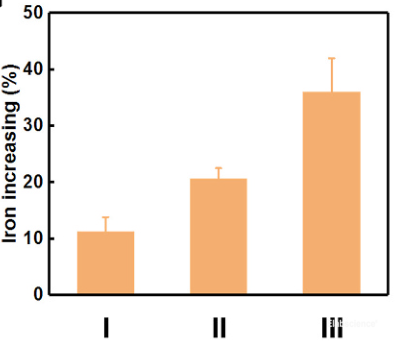Total Iron Colorimetric Assay Kit
SKU: E-BC-K772-M-96
Total Iron Colorimetric Assay Kit
| SKU # | E-BC-K772-M |
| Detection Instrument | Microplate reader (590-600 nm, optimum wavelength: 593 nm) |
| Detection method: | Colorimetric method |
Product Details
Properties
| Sample type | Serum, tissue |
| Sensitivity | 0.4 μmol/L |
| Detection range | 0.4-50 μmol/L |
| Detection method |
Colorimetric method |
| Assay type | Quantitative |
| Assay time | 80 min |
| Precision | Average inter-assay CV: 1.500% | Average intra-assay CV: 1.300% |
| Storage | 2-8℃ |
| Valid period | 12 months |
Images
H Tian et al developed a targeted nanomodulator that can induced tumor cell ferroptosis. Iron (Fe) level in mouse tumor cells 4T1 were determined using total iron colorimetric assay kit (E-BC-K772-M).

The increased iron content in 4T1 cells showed significantly difference between different treatments.
Dilution of Sample
It is recommended to take 2~3 samples with expected large difference to do pre-experiment before formal experiment and dilute the sample according to the result of the pre-experiment and the detection range (0.4-50 μmol/L).
The recommended dilution factor for different samples is as follows (for reference only):
| Sample type | Dilution factor |
| Human serum | 1 |
| Mouse serum | 1-2 |
| Rat serum | 1 |
| 10% Mouse liver tissue homogenate | 2-3 |
| 10% Rat lung tissue homogenate | 1 |
| 10% Mouse heart tissue homogenate | 1 |
| 10% Rat spleen tissue homogenate | 2-3 |
| 10% Epipremnum aureum leaf tissue homogenate | 1 |
Note: The diluent is reagent 1.
Detection Principle
Under the action of reductant, iron ions in samples can be reduced into ferrous ions (Fe2+). The latter then bind to probe and form complexes, which has a maximum absorption peak at 593 nm. The concentration of iron can be calculated by measuring the OD value at 593 nm indirectly.
Kit Components & Storage
| Item | Component | Size 1(48 T) | Size 2(96 T) | Storage |
| Reagent 1 | Buffer Solution | 50 mL × 1 vial | 50 mL × 2 vials | 2-8℃, 12 months, shading light |
| Reagent 2 | Chromogenic Solution |
10 mL × 1 vial | 10 mL × 2 vials | 2-8℃, 12 months, shading light |
| Reagent 3 | 10 mmol/L Iron Standard | 1 mL × 1 vial | 1 mL × 2 vials | 2-8℃, 12 months, shading light |
| Reagent 4 | Extracting Solution | 40 mL × 1 vial | 40 mL × 2 vials | 2-8℃, 12 months, shading light |
| Microplate | 96 wells | No requirement | ||
| Plate Sealer | 2 pieces | |||
Note: The reagents must be stored strictly according to the preservation conditions in the above table. The reagents in different kits cannot be mixed with each other. For a small volume of reagents, please centrifuge before use, so as not to obtain sufficient amount of reagents.
Technical Data:
Parameter:
Intra-assay Precision
Three human serum samples were assayed in replicates of 20 to determine precision within an assay (CV = Coefficient of Variation).
| Parameters | Sample 1 | Sample 2 | Sample 3 |
| Mean (μmol/L) | 1.80 | 16.50 | 40.50 |
| %CV | 1.5 | 1.3 | 1.1 |
Inter-assay Precision
Three human serum samples were assayed 20 times in duplicate by three operators to determine precision between assays.
| Parameters | Sample 1 | Sample 2 | Sample 3 |
| Mean (μmol/L) | 1.80 | 16.50 | 40.50 |
| %CV | 1.2 | 1.7 | 1.6 |
Recovery
Take three samples of high concentration, middle concentration and low concentration to test the samples of each concentration for 6 times parallelly to get the average recovery rate of 99%.
| Standard 1 | Standard 2 | Standard 3 | |
| Expected Conc. (μmol/L) | 7.5 | 18 | 36 |
| Observed Conc. (μmol/L) | 7.6 | 17.8 | 34.9 |
| Recovery rate(%) | 101 | 99 | 97 |
Sensitivity
The analytical sensitivity of the assay is 0.4 μmol/L. This was determined by adding two standard deviations to the mean O.D. obtained when the zero standard was assayed 20 times, and calculating the corresponding concentration.
Standard Curve
As the OD value of the standard curve may vary according to the conditions of the actual assay performance (e.g. operator, pipetting technique or temperature effects), so the standard curve and data are provided as below for reference only:
| Concentration (μmol/L) | 0 | 5 | 10 | 15 | 20 | 30 | 40 | 50 |
| Average OD | 0.048 | 0.136 | 0.232 | 0.326 | 0.417 | 0.611 | 0.795 | 0.978 |
| Absoluted OD | 0.000 | 0.088 | 0.184 | 0.278 | 0.369 | 0.563 | 0.747 | 0.930 |



